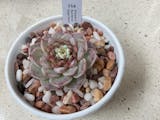Crassula Tetragona is a common ornamental plant originating from South Africa. If you pay close attention, you'll spot this plant in some gardens. The evergreen succulent has leaves that grow in pairs. With an elegantly upright trunk, Crassula Tetragona can reach 3-4 feet and spread about 2-3 feet. Cream-colored flowers bloom in clusters at the top.
It's also known as the Miniature Pine Tree, and like most Crassula plants such as the Jade Plant, it forms woody stems. Coupled with its needle-like leaves, it resembles a pine tree, making it a popular choice for miniature landscape decorations on tabletops.
Now that we've delved into its origins and unique features, let's explore the art of caring for Crassula Tetragona.
How to Care for Crassula Tetragona
Like most succulent plants, Crassula Tetragona isn't demanding regarding care. Following these care guides, you can ensure that your plant thrives and maintains its charming appearance.
Sunlight and Location
Crassula Tetragona thrives in full sunlight outdoors, growing vigorously. This makes them an excellent choice for enhancing your garden, planted directly in the ground or as large succulent trees adorning your porch.

If you're growing Crassula Tetragona indoors as potted succulents, placing them where they can receive sunlight for about 4-6 hours is best. Windows work well; the morning's indirect light prevents leggy growth or yellowing.
Temperature
While various sources suggest Crassula can tolerate 30°F to 50°F, it means if you reside in USDA hardiness zones 10-11, you can keep the plant outdoors year-round. However, Crassula Tetragona truly thrives in temperatures between 65°F to 75°F. So please provide some protection from frost during winter.
Succulents, including Crassula Tetragona, are sensitive to extreme temperature fluctuations. Rapid transitions from warm to cold or vice versa can shock the plant's system, prompting it to shed leaves in response to stress.
Water
Influenced by varying humidity levels, ventilation, and temperature across different environments and seasons, pinpointing an exact watering frequency for Crassula Tetragona can be challenging.
Observe the leaves closely: if they start to soften and the surface shows wrinkling, it's an indicator. Meanwhile, employing a plant moisture meter to confirm complete soil dryness offers added certainty. It's likely time to water. Remember, stick to the "soak and dry" method instead of frequent light watering.

Image Credit: succulentplantcare.com
Prune
Don't hesitate to prune; mastering proper trimming encourages Crassula Tetragona's growth. You can promote more branching by trimming the top, and as it grows, the stems will become woody, transforming into succulent trees.
Remember to sanitize the pruning tools you use. Trim your succulent only after establishing a stable root system, and avoid causing excessive stress.
Soil and Pot
A cactus soil mix with approximately 50% to 70% pumice, perlite, or grit is recommended. Adjust the specific ratio based on the size of the succulent and the humidity of its environment. A 50% grit content in the soil is sufficient for more miniature succulents to support rapid growth by providing necessary nutrients. Larger succulents prefer higher grit content, with around 70% being adequate. If you reside in a region with consistent rain and high humidity, consider increasing the proportion of gritty soil.
Considering the aesthetic appeal of Crassula Tetragona, opt for shallow pots when planting them. Their upright growth resembles miniature pine trees, creating a delightful indoor forest scene that brings a sense of tranquility and joy to your space.

How to Propagate Crassula Tetragona
Propagating Crassula Tetragona is just as effortless as propagating Jade Plants. The most common method is stem propagation. You can use trimmed stems, allow the cut to dry, then plant them in moist soil. After 1-2 weeks, gently lift the succulent, and if you feel a subtle resistance as roots grip the soil, success is yours.

Leaf propagation might pose a bit more challenge, but snipping a pair of leaves can enhance your chances of success.
You may want to know: Extra Tips on Succulent Propagation From Leaves Cuttings.
Common Problems
Leaf dropping
Leaf dropping is the most common issue. If the upper leaves begin to yellow and lose their upright growth, consider reviewing the care practices mentioned earlier. Extreme temperature fluctuations and overwatering are often the direct culprits. To address this concern, adjust your watering frequency, following the guidelines we discussed on how to water Crassula Tetragona.

Image Credit: Reddit@derelictparadise
Leaf spot
Spots on Crassula Tetragona leaves are typically caused by sunburn, fungal infection, and sooty mold. Differentiate between these types of spots by referring to the images below.
The most common are dark or brown spots resulting from fungal infections. To address this, promptly remove the infected leaves to prevent spreading, and apply a diluted fungicide spray on the succulent's leaves to control the issue.
You may wonder: A full guide on Spots on Succulents and Solutions.

Image Credit:Reddit@Dark_Shad0w
Crassula Tetragona, Sedum Corynephyllum Fröd, and Curio repens
Crassula Tetragona, Sedum Corynephyllum Fröd, and Curio repens, these three succulents belong to different genus, yet they share striking visual similarities. Common traits include their upright growth habit and small, slender leaves. However, upon closer observation, subtle differences become apparent. Take a look at the images below for a side-by-side comparison, and you'll discover the distinctive characteristics that set these three plants apart.



























